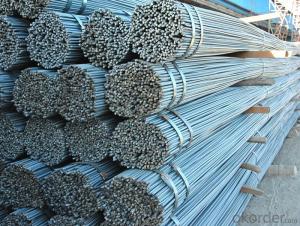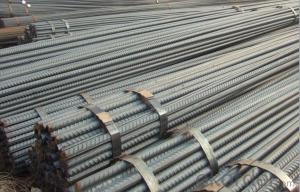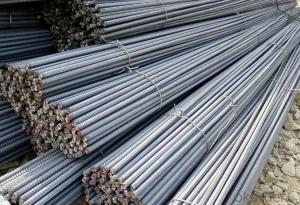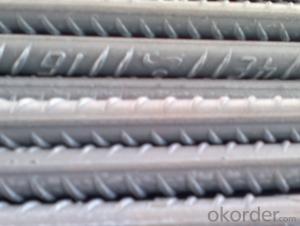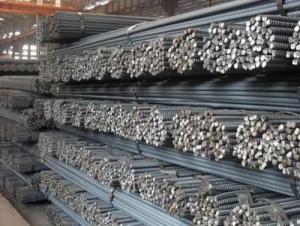Hot rolled high quality deformed bar 10-50mm
- Loading Port:
- Tianjin
- Payment Terms:
- TT OR LC
- Min Order Qty:
- 25 m.t.
- Supply Capability:
- 25000 m.t./month
OKorder Service Pledge
OKorder Financial Service
You Might Also Like
Deformed Bar Details:
| Minimum Order Quantity: | Unit: | m.t. | Loading Port: | ||
| Supply Ability: | Payment Terms: | Package: | wire rod packing |
Product Description:
Product Description:
Specifications of HRB400 Deformed Steel Bar:
Standard | GB | HRB400 | |
Diameter | 6mm,8mm,10mm,12mm,14mm,16mm,18mm,20mm, 22mm,25mm,28mm,32mm,36mm,40mm,50mm | ||
Length | 6M, 9M,12M or as required | ||
Place of origin | Hebei, China mainland | ||
Advantages | exact size, regular package, chemical and mechanical properties are stable. | ||
Type | Hot rolled deformed steel bar | ||
Brand name | DRAGON | ||
Chemical Composition: (Please kindly find our chemistry of our material based on HRB500 as below for your information)
Grade | Technical data of the original chemical composition (%) | ||||||
C | Mn | Si | S | P | V | ||
HRB400 | ≤0.25 | ≤1.60 | ≤0.80 | ≤0.045 | ≤0.045 | 0.04-0.12 | |
Physical capability | |||||||
Yield Strength (N/cm²) | Tensile Strength (N/cm²) | Elongation (%) | |||||
≥400 | ≥570 | ≥14 | |||||
Theoretical weight and section area of each diameter as below for your information:
Diameter(mm) | Section area (mm²) | Mass(kg/m) | Weight of 12m bar(kg) |
6 | 28.27 | 0.222 | 2.664 |
8 | 50.27 | 0.395 | 4.74 |
10 | 78.54 | 0.617 | 7.404 |
12 | 113.1 | 0.888 | 10.656 |
14 | 153.9 | 1.21 | 14.52 |
16 | 201.1 | 1.58 | 18.96 |
18 | 254.5 | 2.00 | 24 |
20 | 314.2 | 2.47 | 29.64 |
22 | 380.1 | 2.98 | 35.76 |
25 | 490.9 | 3.85 | 46.2 |
28 | 615.8 | 4.83 | 57.96 |
32 | 804.2 | 6.31 | 75.72 |
36 | 1018 | 7.99 | 98.88 |
40 | 1257 | 9.87 | 118.44 |
50 | 1964 | 15.42 | 185.04 |
Usage and Applications of HRB400 Deformed Steel Bar:
Deformed bar is widely used in buildings, bridges, roads and other engineering construction. Big to highways, railways, bridges, culverts, tunnels, public facilities such as flood control, dam, small to housing construction, beam, column, wall and the foundation of the plate, deformed bar is an integral structure material. With the development of world economy and the vigorous development of infrastructure construction, real estate, the demand for deformed bar will be larger and larger..
Packaging & Delivery of HRB400 Deformed Steel Bar:
Packaging Detail: products are packed in bundle and then shipped by container or bulk vessel, deformed bar is usually naked strapping delivery, when storing, please pay attention to moisture proof. The performance of rust will produce adverse effect.
Each bundle weight: 2-3MT, or as required
Payment term: TT or L/C
Delivery Detail: within 45 days after received advanced payment or LC.
Label: to be specified by customer, generally, each bundle has 1-2 labels
Trade terms: FOB, CFR, CIF
- Q:Are there any restrictions on the use of steel rebars in certain regions?
- Yes, there are certain restrictions on the use of steel rebars in certain regions. These restrictions can vary from region to region and are typically put in place to ensure the safety and integrity of structures. In some areas, building codes and regulations may dictate specific requirements for the use of steel rebars, such as the type, size, and placement of rebars. Additionally, there may be restrictions on the use of certain types of steel rebars, such as epoxy-coated rebars, due to environmental concerns. It is important for construction professionals to familiarize themselves with the local building codes and regulations to ensure compliance and promote the safety and durability of structures.
- Q:How do steel rebars affect the overall cost of a construction project?
- Steel rebars can significantly impact the overall cost of a construction project. These reinforcement bars are vital for providing structural strength and stability to concrete structures. The cost of steel rebars depends on factors such as quantity, quality, and market prices. As rebars are typically priced per ton, the more reinforcement required, the higher the cost. Moreover, fluctuations in steel prices can affect overall project expenses. However, the investment in steel rebars is crucial to ensure the durability and safety of the construction, making it a necessary expense in most projects.
- Q:What are the guidelines for spacing and positioning steel rebars in concrete structures?
- The guidelines for spacing and positioning steel rebars in concrete structures are critical to ensure the structural integrity and durability of the construction. Here are some key guidelines to follow: 1. Rebar Spacing: The spacing between steel rebars in concrete structures is determined by the structural engineer or designer. It is typically expressed in terms of center-to-center spacing or clear distance between rebars. The spacing depends on the load requirements, concrete strength, and other factors specific to the project. The most common spacing ranges from 4 to 12 inches. 2. Cover Depth: The concrete cover depth refers to the distance between the outer surface of the concrete and the nearest surface of the rebar. It is essential to provide adequate cover to protect the rebars from environmental factors, such as corrosion and fire. The cover depth is typically specified in the project's design and can vary depending on the concrete's exposure conditions. 3. Rebar Positioning: The proper positioning of rebars is crucial to ensure they are placed in the designated locations within the concrete structure. The rebars should be securely supported and maintained in the correct alignment during the concrete pouring process. The positioning requirements may include specific lap lengths, overlaps, or hooking of rebars at junctions to ensure proper load transfer and structural continuity. 4. Chair Supports: Rebar chair supports are widely used to maintain the correct spacing and elevation of the rebars within the concrete structure. These supports are placed under the rebars at regular intervals to prevent sagging or displacement during concrete placement. The appropriate chair support type and height should be selected based on the project's requirements and the diameter of the rebars. 5. Tying and Binding: Proper tying and binding of rebars are essential to ensure they remain in position and maintain the required spacing during the concrete pouring process. Rebars should be tied securely using wire or rebar ties at appropriate intervals, typically every 12-18 inches. The ties should be tight enough to prevent movement but not overly tight to avoid damaging the rebars or causing concrete segregation. 6. Concrete Consolidation: During concrete placement, it is crucial to properly consolidate the concrete around the rebars to eliminate air voids and ensure adequate bonding between the concrete and the rebars. Vibrators or other consolidation techniques should be used to achieve proper compaction and ensure the rebars are thoroughly embedded in the concrete. Compliance with the guidelines for spacing and positioning steel rebars in concrete structures is essential to guarantee the structural strength, durability, and safety of the construction. It is crucial to consult and follow the project's design specifications and engage qualified professionals to ensure proper execution and adherence to these guidelines.
- Q:How do steel rebars affect the overall vibration resistance of a structure?
- Steel rebars can significantly enhance the overall vibration resistance of a structure. By providing additional strength and stiffness, rebars increase the structural integrity and help to distribute and dissipate vibrational energy. This reinforcement effectively reduces the magnitude of vibrations and minimizes the risk of structural damage or failure during dynamic events, such as earthquakes or high winds.
- Q:How long do steel rebars last?
- Steel rebars have a lifespan of approximately 50 to 100 years, depending on factors such as environmental conditions, maintenance, and quality of the steel.
- Q:How do steel rebars contribute to the overall sustainability of a project?
- Steel rebars contribute to the overall sustainability of a project by enhancing the durability and strength of reinforced concrete structures. This allows for longer lifespan, reduced maintenance needs, and decreased material waste over time. Additionally, steel rebars can be recycled, reducing the demand for new steel production and minimizing the environmental impact of the project.
- Q:How do steel rebars affect the overall sustainability of a construction project?
- Steel rebars can have a significant impact on the overall sustainability of a construction project. Firstly, steel rebars are commonly used to reinforce concrete structures, enhancing their strength and durability. By increasing the longevity of the building, steel rebars help minimize the need for frequent repairs or replacements, reducing the consumption of materials and energy required for maintenance over the long term. Moreover, steel rebars contribute to the structural integrity of a construction project, allowing for the design of lighter and more efficient structures. This results in reduced material usage, as well as lower energy consumption during the construction process. Additionally, the use of steel rebars can often lead to the construction of slimmer and more aesthetically appealing structures, which can have a positive impact on the environmental footprint of the project. Steel rebars are also recyclable, which further enhances the sustainability of a construction project. At the end of a building's life cycle, steel rebars can be easily recovered and reused, reducing the demand for new steel production. Recycling steel rebars not only conserves natural resources but also significantly reduces greenhouse gas emissions associated with the steel manufacturing process. Furthermore, steel rebars can contribute to the overall sustainability of a construction project by improving the building's resilience to natural disasters such as earthquakes or hurricanes. By providing additional strength and flexibility to the structure, steel rebars can help minimize damage and potentially save lives. In summary, steel rebars positively impact the overall sustainability of a construction project by enhancing the structural integrity and durability of buildings, reducing material and energy consumption, promoting recycling and reuse, and improving resilience to natural disasters. Their usage is a crucial component in creating more sustainable and environmentally friendly construction practices.
- Q:How do steel rebars perform in extreme temperature conditions?
- Steel rebars perform well in extreme temperature conditions. Steel has a high melting point and thermal conductivity, allowing it to maintain its structural integrity even at elevated temperatures. Additionally, steel has a low coefficient of thermal expansion, reducing the risk of cracking or warping due to thermal stress. However, it is important to consider the specific grade and composition of the steel rebar, as certain alloys may exhibit different behavior in extreme temperatures.
- Q:Are steel rebars prone to rusting?
- Yes, steel rebars are prone to rusting. Rebars are made of carbon steel, which contains iron as its primary component. When exposed to moisture and oxygen, the iron in steel rebars undergoes a chemical reaction called oxidation, resulting in the formation of iron oxide or rust. This process can be accelerated in environments with high humidity, coastal areas with saltwater exposure, or when the rebars come into contact with water or other corrosive substances. The rusting of steel rebars can weaken their structural integrity and compromise the strength and durability of concrete structures. Therefore, it is essential to protect rebars from rust by applying anti-corrosion coatings or using stainless steel rebars in areas prone to rusting. Regular maintenance and inspection can also help identify and address any rust-related issues in a timely manner.
- Q:What is the role of steel rebars in preventing structural collapse?
- Steel rebars play a crucial role in preventing structural collapse by reinforcing concrete structures. Concrete, although strong in compression, is relatively weak in tension. This is where steel rebars come into play, as they effectively enhance the tensile strength of the concrete. When structural loads are applied to a building or other concrete structure, the rebars distribute the load across a wider area, preventing the concrete from cracking and failing under the stress. By providing a means for the concrete to resist tension and bending forces, steel rebars help maintain the integrity and stability of the structure. In addition to improving tensile strength, rebars also enhance the overall ductility and flexibility of the concrete. This is critical during events such as earthquakes or high winds, where structures need to withstand significant lateral forces. The presence of rebars helps the concrete to absorb and dissipate these forces, reducing the risk of structural failure. Moreover, steel rebars also prevent structural collapse by resisting the effects of corrosion. When embedded in concrete, rebars are protected from moisture and other corrosive elements, ensuring their long-term durability and ability to support the structure. In summary, steel rebars are essential components in preventing structural collapse. They reinforce concrete structures, enhance tensile strength, improve ductility, resist corrosion, and ultimately contribute to the overall safety and stability of buildings and other concrete constructions.
1. Manufacturer Overview |
|
|---|---|
| Location | |
| Year Established | |
| Annual Output Value | |
| Main Markets | |
| Company Certifications | |
2. Manufacturer Certificates |
|
|---|---|
| a) Certification Name | |
| Range | |
| Reference | |
| Validity Period | |
3. Manufacturer Capability |
|
|---|---|
| a)Trade Capacity | |
| Nearest Port | |
| Export Percentage | |
| No.of Employees in Trade Department | |
| Language Spoken: | |
| b)Factory Information | |
| Factory Size: | |
| No. of Production Lines | |
| Contract Manufacturing | |
| Product Price Range | |
Send your message to us
Hot rolled high quality deformed bar 10-50mm
- Loading Port:
- Tianjin
- Payment Terms:
- TT OR LC
- Min Order Qty:
- 25 m.t.
- Supply Capability:
- 25000 m.t./month
OKorder Service Pledge
OKorder Financial Service
Similar products
New products
Hot products
Hot Searches
Related keywords
